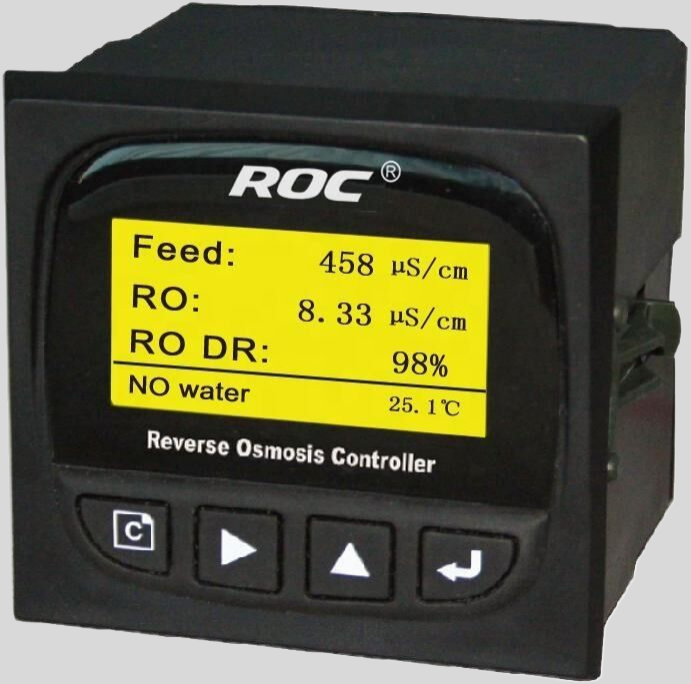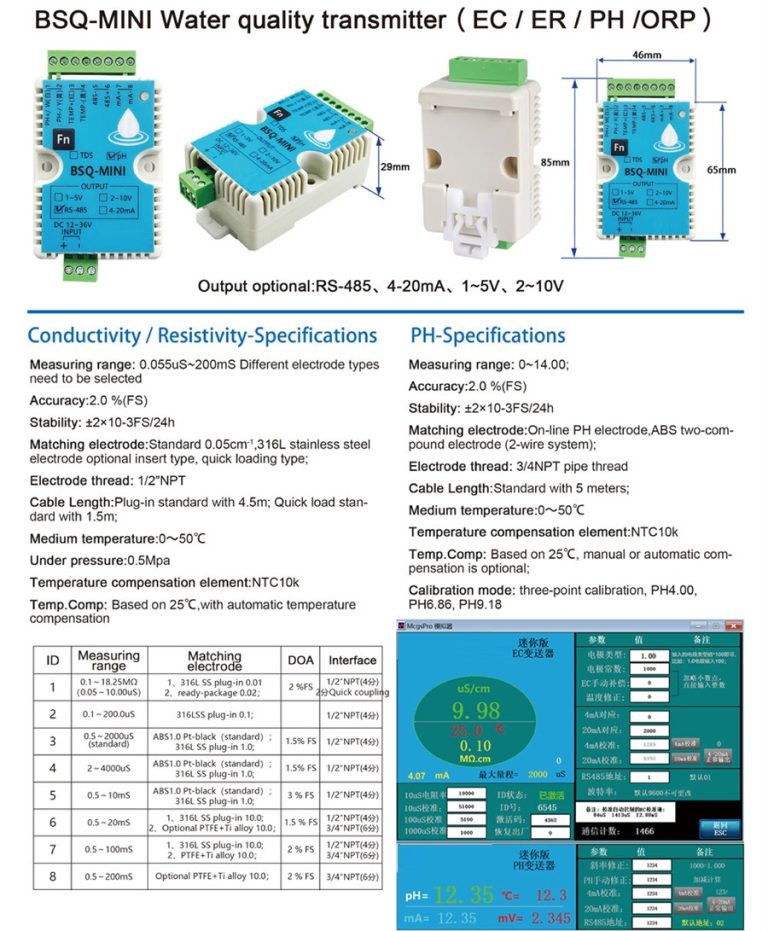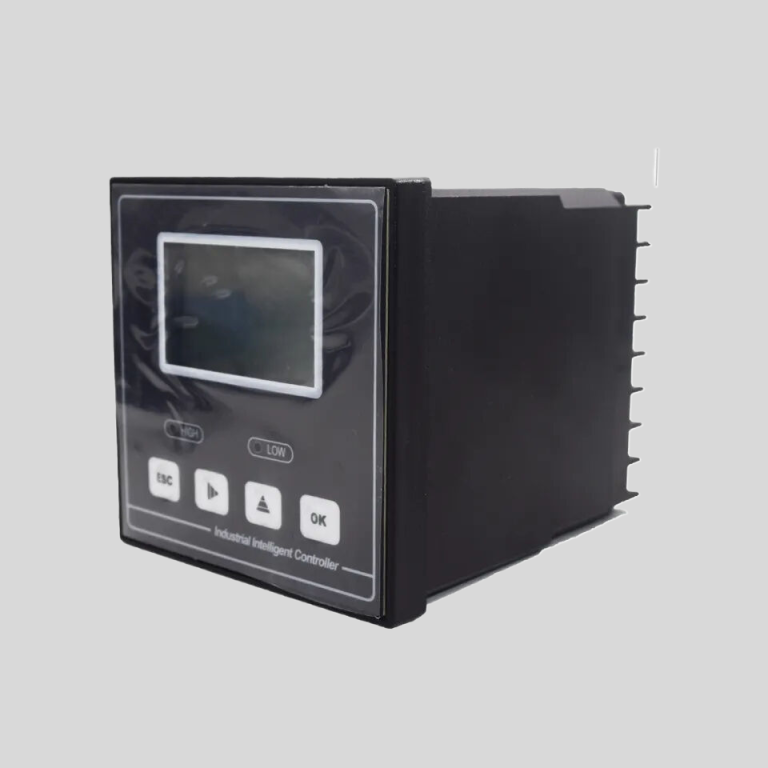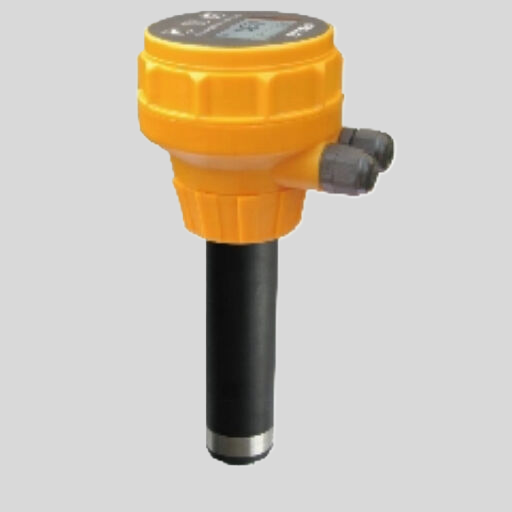Table of Contents
Benefits of Using a digital ph meter for Water Testing
A digital ph meter is a device used to measure the acidity or alkalinity of a liquid. It is an essential tool for water testing, as pH levels can have a significant impact on the quality of water. By using a digital ph meter, you can accurately determine the pH level of water, which can help you make informed decisions about water treatment and ensure the safety of the water you are using.
| ROS-8600 RO Program Control HMI Platform | ||
| Model | ROS-8600 Single Stage | ROS-8600 Double Stage |
| Measuring range | Source water0~2000uS/cm | Source water0~2000uS/cm |
| \u3000 | First level effluent 0~200uS/cm | First level effluent 0~200uS/cm |
| \u3000 | secondary effluent 0~20uS/cm | secondary effluent 0~20uS/cm |
| Pressure sensor(optional) | Membrane pre/post pressure | Primary/ secondary membrane front/rear pressure |
| ph sensor(optional) | —- | 0~14.00pH |
| Signal collection | 1.Raw water low pressure | 1.Raw water low pressure |
| \u3000 | 2.Primary booster pump inlet low pressure | 2.Primary booster pump inlet low pressure |
| \u3000 | 3.Primary booster pump outlet high pressure | 3.Primary booster pump outlet high pressure |
| \u3000 | 4.High liquid level of Level 1 tank | 4.High liquid level of Level 1 tank |
| \u3000 | 5.Low liquid level of Level 1 tank | 5.Low liquid level of Level 1 tank |
| \u3000 | 6.Preprocessing signal\u00a0 | 6.2nd booster pump outlet high pressure |
| \u3000 | 7.Input standby ports x2 | 7.High liquid level of Level 2 tank |
| \u3000 | \u3000 | 8.Low liquid level of Level 2 tank |
| \u3000 | \u3000 | 9.Preprocessing signal |
| \u3000 | \u3000 | 10.Input standby ports x2 |
| Output control | 1.Water inlet valve | 1.Water inlet valve |
| \u3000 | 2.Source water pump | 2.Source water pump |
| \u3000 | 3.Primary booster pump | 3.Primary booster pump |
| \u3000 | 4.Primary flush valve | 4.Primary flush valve |
| \u3000 | 5.Primary dosing pump | 5.Primary dosing pump |
| \u3000 | 6.Primary water over standard discharge valve | 6.Primary water over standard discharge valve |
| \u3000 | 7.Alarm output node | 7.Secondary booster pump |
| \u3000 | 8.Manual standby pump | 8.Secondary flush valve |
| \u3000 | 9.Secondary dosing pump | 9.Secondary dosing pump |
| \u3000 | Output standby port x2 | 10.Secondary water over standard discharge valve |
| \u3000 | \u3000 | 11.Alarm output node |
| \u3000 | \u3000 | 12.Manual standby pump |
| \u3000 | \u3000 | Output standby port x2 |
| The main function | 1.Correction of electrode constant | 1.Correction of electrode constant |
| \u3000 | 2.Overrun alarm setting | 2.Overrun alarm setting |
| \u3000 | 3.All working mode time can be set | 3.All working mode time can be set |
| \u3000 | 4.High and low pressure flushing mode setting | 4.High and low pressure flushing mode setting |
| \u3000 | 5.The low pressure pump is opened when preprocessing | 5.The low pressure pump is opened when preprocessing |
| \u3000 | 6.Manual/automatic can be chosen when boot up | 6.Manual/automatic can be chosen when boot up |
| \u3000 | 7.Manual debugging mode | 7.Manual debugging mode |
| \u3000 | 8.Alarm if communication interruption | 8.Alarm if communication interruption |
| \u3000 | 9. Urging payment settings | 9. Urging payment settings |
| \u3000 | 10. Company name,website can be customized | 10. Company name,website can be customized |
| Power supply | DC24V\u00b110% | DC24V\u00b110% |
| Expansion interface | 1.Reserved relay output | 1.Reserved relay output |
| \u3000 | 2.RS485 communication | 2.RS485 communication |
| \u3000 | 3.Reserved IO port, analog module | 3.Reserved IO port, analog module |
| \u3000 | 4.Mobile/computer/touch screen synchronous display\u00a0 | 4.Mobile/computer/touch screen synchronous display\u00a0 |
| Relative humidity | \u226685% | \u226485% |
| Environment temperature | 0~50\u2103 | 0~50\u2103 |
| Touch screen size | 163x226x80mm (H x W x D) | 163x226x80mm (H x W x D) |
| Hole Size | 7 inch:215*152mm(wide*high) | 215*152mm(wide*high) |
| Controller size | 180*99(long*wide) | 180*99(long*wide) |
| Transmitter size | 92*125(long*wide) | 92*125(long*wide) |
| Installation method | Touch screen:panel embedded; Controller: plane fixed | Touch screen:panel embedded; Controller: plane fixed |
One of the main benefits of using a digital ph meter for water testing is its accuracy. Digital pH meters are designed to provide precise and reliable measurements, allowing you to get an accurate reading of the pH level of water. This is important because even small variations in pH levels can have a significant impact on the quality of water. By using a digital ph meter, you can ensure that you are getting accurate and reliable results, which can help you make informed decisions about water treatment.
Another benefit of using a digital ph meter for water testing is its ease of use. Digital pH meters are designed to be user-friendly, with simple and intuitive controls that make it easy to take measurements. This makes it easy for anyone to use a digital ph meter, regardless of their level of experience with water testing. Additionally, digital pH meters often come with features such as automatic calibration and temperature compensation, which can help ensure accurate and reliable results.
In addition to accuracy and ease of use, digital pH meters also offer convenience. Digital pH meters are portable and compact, making them easy to transport and use in different locations. This means that you can easily take a digital ph meter with you when testing water in different areas, such as at home, in the field, or in a laboratory. This convenience allows you to quickly and easily test the pH level of water wherever you are, without the need for complex equipment or specialized training.
Furthermore, digital pH meters are often more cost-effective than traditional pH testing methods. While traditional pH testing methods may require the use of expensive equipment and chemicals, digital pH meters are relatively affordable and require minimal maintenance. This makes digital pH meters a cost-effective option for water testing, allowing you to save money while still getting accurate and reliable results.

Overall, using a digital ph meter for water testing offers a range of benefits, including accuracy, ease of use, convenience, and cost-effectiveness. By using a digital ph meter, you can ensure that you are getting accurate and reliable measurements of the pH level of water, which can help you make informed decisions about water treatment and ensure the safety of the water you are using. Whether you are testing water at home, in the field, or in a laboratory, a digital ph meter is an essential tool for ensuring the quality of water.
How to Calibrate and Maintain Your digital ph meter for Accurate Readings
A digital ph meter is a valuable tool used in various industries, including agriculture, food and beverage production, water treatment, and scientific research. This device measures the acidity or alkalinity of a solution by detecting the concentration of hydrogen ions present. Accurate pH readings are crucial for ensuring the quality and safety of products, as well as for conducting experiments and research. To maintain the accuracy of your digital ph meter, it is essential to calibrate and maintain it regularly.
Calibration is the process of adjusting the readings of a ph meter to match a known standard. This ensures that the device provides accurate and reliable measurements. Most digital pH meters come with calibration solutions that have a known pH value, typically pH 4.01, pH 7.00, and pH 10.01. To calibrate your ph meter, you will need to immerse the electrode in each calibration solution and adjust the readings accordingly. It is important to follow the manufacturer’s instructions for calibration, as the process may vary depending on the model of the ph meter.
After calibrating your digital ph meter, it is crucial to maintain it properly to ensure accurate readings. One of the most important maintenance tasks is to keep the electrode clean. Over time, the electrode can become coated with residue from the solutions being measured, which can affect the accuracy of the readings. To clean the electrode, gently rinse it with distilled water and wipe it with a soft cloth. Avoid using harsh chemicals or abrasive materials, as they can damage the electrode.
In addition to cleaning the electrode, it is important to store the ph meter properly when not in use. Most digital pH meters come with a storage solution that helps keep the electrode hydrated and prevents it from drying out. Make sure to store the electrode in the storage solution when not in use, and replace the solution regularly to prevent contamination.
Regularly checking the condition of the electrode is also essential for maintaining the accuracy of your digital ph meter. Inspect the electrode for any signs of damage, such as cracks or chips, and replace it if necessary. It is also a good idea to check the calibration of the ph meter periodically to ensure that it is still providing accurate readings. If the readings are consistently off, recalibrate the ph meter to correct any errors.
In conclusion, calibrating and maintaining your digital ph meter is essential for ensuring accurate and reliable measurements. By following the manufacturer’s instructions for calibration, cleaning the electrode regularly, storing the ph meter properly, and checking the condition of the electrode, you can prolong the life of your device and ensure that it continues to provide accurate readings. Taking these steps will help you get the most out of your digital ph meter and ensure the quality and safety of your products or research.







